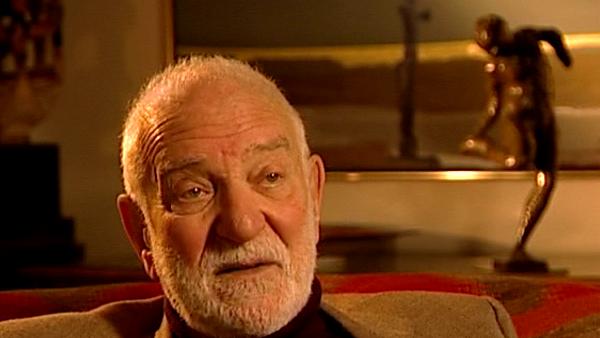NEXT STORY

Sculpture is my life
RELATED STORIES

NEXT STORY

Sculpture is my life
RELATED STORIES


|
Views | Duration | |
|---|---|---|---|
| 31. Inspiration from paintings | 228 | 06:23 | |
| 32. My first visit to Greece | 123 | 01:18 | |
| 33. Greek art made real | 116 | 03:55 | |
| 34. Travel and sculpture: Medicine Hat | 105 | 03:42 | |
| 35. Working in ceramic clay with Hans Spinner | 383 | 04:00 | |
| 36. The Trojan War | 205 | 04:18 | |
| 37. The Last Judgement | 212 | 04:05 | |
| 38. Sculpture is my life | 144 | 02:09 | |
| 39. My sense of rhythm | 155 | 04:08 | |
| 40. You need to show your work | 103 | 01:44 |


I... I didn't know what to call it. I didn't call it "The Last Judgement"; I just called it a... a "Group of Sculptures". And then I gave it a working title of "The Last Judgement", and then the guy, Worth, came to the studio and loved it and said, ‘It's marvellous’, and, ‘What's it called?’ And I said, ‘I don't know; I want to call it "The Last Judgement"; I'm calling it "The Last Judgement" for now’. He said, ‘Then you have to call it "The Last Judgement", you have to call it "The Last Judgement"’. So I called it "The Last Judgement". But it is "The Last Judgement" really, isn't it, in a way?
[Q] Yeah, it is. And you made that when you were in your seventies. Is that something that you think is only a subject that you could wrestle with, you know, in your... in your mature years? I mean is it a subject that... that deals with mortality in the way that younger artists don't necessarily come to terms with or confront?
I have no idea. I've no idea and I don't find it; looking back, which I don't like to do, I have my doubts about that sort of sculpture. It's so romantic; I have my doubts about that sort of sculpture. I'm not sure... I'm not really happier. This shouldn't be on the tape but let's leave it. I mean I think I am really an abstract artist but why shouldn't you do these things? And I think you get your... in your seventies you have the freedom to do that, to feel that and I feel, you know, it's like taking... it's like... it's like Goya's prints as opposed to Goya's paintings. So it's a sort of subsidiary thing, I think, sort of social and narrative and all these things. So I don't want to do much of it. I like to do it sometimes but I don't want to do much of it. I would rather make abstract sculpture in the end.
[Q] It was also perceived... and I think you alluded to conflict, both generalised conflict and also, you know, the Bosnian conflict. So that was a trigger too, or did the work suddenly suggest that to you?
We were bombarded with... with Bosnian... Bosnian thing and, you know, it was... it was just like we’re bombarded with Iraq now. We're bombarded with it; it's in the... in our faces, these awful things that are happening, and you can't go through life nowadays without it hitting you in some way, can you? I mean, you know, Iraq, people being killed in Iraq, soldiers, Iraqis, everything, the whole damn time. And, you know, you can't just ignore it; it's... it’s more than that. But it's a subject for sculpture; it's a subject for sculpture. In a way it's a... it's a step back to get into a subject for sculpture because I think that, you know, the subject for sculpture is sculpture... that's how I see it. And that has almost stopped happening now, especially with these monuments and things. But, you know, our time we were trying to... we were focusing on sculpture as... as a... as a discipline, as a practice, and ‘Let's try and do everything we can to build this up afresh’. It wasn't for telling stories, you know. It wasn't for using; it was for itself. So it's fine to do it a bit but I don't think I want to... I don't think I want to make a life of it.
British sculptor Sir Anthony Caro (1924-2013) came to prominence in 1963 after a show at the Whitechapel Gallery. Keen to create a more direct interaction with the viewer he placed pieces directly on the ground, rather than on plinths, a technique now widely used. He held many honorary degrees and was knighted in 1987.
Title: "The Last Judgement"
Listeners: Tim Marlow
Tim Marlow is a writer, broadcaster and art historian. He founded "Tate: The Art Magazine" in 1993 and was presenter of Radio 4 arts programme "Kaleidoscope" from 1991 to 1998, for which he won a Sony Award. He has presented art programme's on BBC 1, Channel 4 and Channel 5, including a documentary about JMW Turner, and written about art and culture for various British newspapers and magazines including "The Guardian", "The Times" and "Blueprint" He is Director of Exhibitions at the White Cube gallery in London as well as a visiting lecturer at Winchester School of Art, an examiner on the Sculpture MA there and former creative director of Sculpture at Goodwood
Tags: the Last Judgement, Group of Sculptures, Iraq, Francisco Goya
Duration: 4 minutes, 5 seconds
Date story recorded: November 2005
Date story went live: 24 January 2008